A closer look at an artist widely regarded as the French Impressionist par excellence, from his love of drawing to his private passion for sculpture, his fascination with dancers and horses to his experiments with photography
His father wanted him to become a lawyer
Hilaire-Germain-Edgar De Gas (1834–1917) was born in Paris, France, in 1834. He was the eldest of five children of Augustin De Gas, a wealthy banker, and Célestine Musson De Gas, a Creole woman from New Orleans, who died when Degas was 13.
Just days after having completed his schooling in 1853, Degas registered as a copyist at the Louvre, where he made studies of Greek and Roman sculptures. Augustin appreciated his son’s artistic talent, but he wanted his son to become a lawyer. Degas duly enrolled in law school, but soon dropped out.
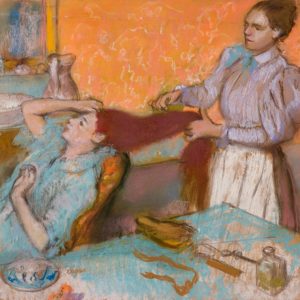
Edgar Degas (1834-1917), ‘La Coiffure’ (La Toilette), c. 1892-1895. Pastel on joined tracing paper laid down on card laid down on board. 21¾ × 22¼ in (55.2 × 56.5 cm).
Jean-Auguste-Dominique Ingres was a formative influence
In 1855, Edgar Degas entered the famed École des Beaux-Arts in Paris. He also attended drawing classes at the atelier of painter Louis Lamothe, a student of Jean-Auguste-Dominique Ingres. It is likely that through Lamothe Degas met Ingres in 1885.
As a student, Degas frequently enlisted his immediate family as subjects. His drawings of family members, which reflect Ingres’ deep influence, helped Degas explore the placement of figures against the dark ground frequently seen in his early oils. Throughout the 1850s, his sister Thérèse was one of his favoured models. He also painted many portraits of his brother René.
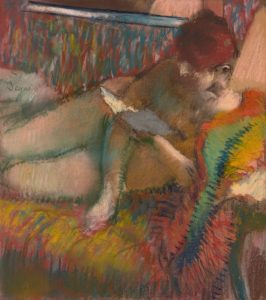
Edgar Degas (1834-1917), ‘Femme lisant’ c. 1883-1885. Pastel over monotype on paper. 12⅞ × 11½ in (32.7 × 29.2 cm).
His teachers encouraged him to copy the Old Masters at the Louvre
This became a key component of his early practice. Degas made numerous copies of works by Michelangelo, Raphael and other Renaissance artists, but — contrary to convention — he usually concentrated on a detail, a secondary figure, or a head, so as to focus on the psychological aspects of human expression.
In 1859, Degas turned his attention to painting historical pieces
While his notebooks from this time contain studies for numerous compositions, Degas ultimately completed only five large-scale historical paintings. In one of these, Alexander and Bucephalus (1861), Degas drew upon the life of Alexander the Great. The influence of the Old Masters is evident not only in terms of subject matter, but also the opulent colours and dense brushwork. The work is now in the National Gallery in Washington, D.C.
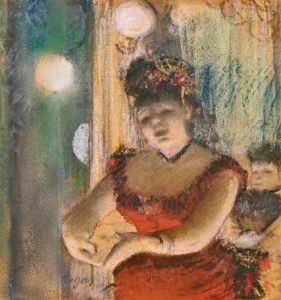
Edgar Degas (1834-1917), ‘Chanteuse de café concert’ 1879. Pastel over monotype on joined paper laid down on board. 6¾ × 6⅜ in (17 × 16.2 cm).
Degas developed his deep love of drawing at Lamothe’s atelier, which taught drawing from the live nude
In July 1856, Degas travelled to Italy, where he remained for three years. In Rome, he participated in public drawing classes at the Académie de France, making a rigorous study of the body and its musculature. It is perhaps ironic that Degas is generally considered the Impressionist artist par excellence. Though he would exhibit with the Impressionists, he considered himself a Realist above all, and strongly rejected the Impressionist label throughout his life.
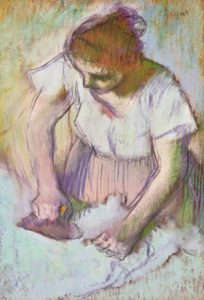
Edgar Degas (1834-1917), ‘Repasseuse’ c. 1870-1872. Pastel and charcoal on paper laid down on board. 27⅞ x 19 in (70.8 x 48.1 cm).
Degas was also a sculptor, but did not make pieces for public consumption
In fact, few people apart from Degas’ close friends knew of his work in wax and cast bronze. The only sculpture Degas ever exhibited publicly was The Little Fourteen-Year-Old Dancer, which was included in the 1881 Impressionist exhibit in Paris. In a radical break from 19th-century academic conventions, the wax figure was outfitted with a real tulle skirt, beribboned wig, shoes and stockings.
The piece deeply offended contemporary critics like Elie de Mont, who wrote, ‘I don’t ask that art should always be elegant, but I don’t believe that its role is to champion the cause of ugliness.’ Others called it ‘repulsive’, ‘vicious’, and ‘a threat to society’. It was not shown again until 1920. When Degas died in 1917, more than 150 wax sculptures were discovered in his studio. Most are now in the National Gallery of Art, in Washington, D.C.
Dancers were frequent subjects in his art, particularly the dancers of the Paris Opéra
If the ballet was the height of fantasy and aspiration, Degas looked at that world with a realist’s eye. The so-called ‘opera rats’ whom he used as models, including the model for The Little Fourteen-Year-Old Dancer, were generally poor or working-class girls, and were frequently preyed upon by the Opera’s wealthy male patrons.
Degas captured his subjects behind the scenes: stretching, or simply waiting backstage. Ingres was far from enthused by Degas’ paintings of dancers, saying of them, ‘We see wretches disfigured by their efforts, red, inflamed with fatigue, and so indecently strapped-up that they would be more modest if they were naked.’
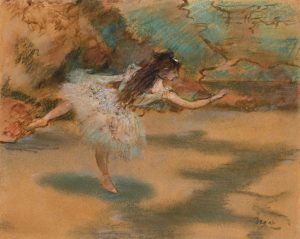
Edgar Degas (1834-1917), ‘Danseuse sur une pointe’ c. 1877. Pastel and pen and brush and sepia ink over pencil on paper laid down on card. 6¾ × 8¼ in (17 × 21 cm)
Degas’ interest in the nude figure, particularly the female nude, persisted throughout his career
Perhaps most of all, it was in his nude studies that he introduced new ideas and deepened his artistic practice. His paintings of women in the bath or at their toilette constitute a major theme in his work. Like his dancers, Degas’ female nudes were not idealised but, as Joris-Karl Huysmans described, ‘real, living, undressed flesh’.
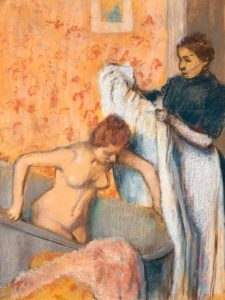
Edgar Degas (1834-1917), ‘Après le Bain’ 1883. Pastel on joined tracing paper laid down on card laid down on board. 20½ × 15½ in (51.9 × 39.2 cm).
Degas began to develop problems with his eyesight in the 1870s
It was partly for this reason that he took up sculpture and, later, photography. In addition to leading him to take up new mediums, his deteriorating condition had significant effects on his painting: colours became bolder and brighter, brushstrokes grew rougher and scenes blurrier, almost abstract. Degas even used his hands to apply paint.
Degas came to appreciate photography’s capacity to provide a sharper perspective, although he only shared his photographs with a small circle of friends and family. Sadly, fewer than 50 of his photographs survive. But those we do have reveal his interest in experimentation and his aesthetic affinities for Symbolism, as reflected in photographs in which his subjects seem to emerge from darkness.
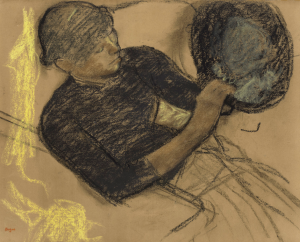
Edgar Degas (1834-1917), ‘Chez la modiste (modiste garnissant un chapeau)’ 1885. Pastel and charcoal on paper. 18⅛ × 23⅛ in (46 × 58.8 cm)
Horses and horse racing were also key subjects for the artist, who was fascinated by the study of movement
Degas produced some 45 oil paintings of horse races, in addition to sculptures, pastels and studies of horses. Rather than document the race itself, his oils focused on the moments just before its start, when both horse and rider were filled with nervous energy.
In 1892, Degas’ Dans un café, or L’absinthe (1875-76), became the first Impressionist work offered at Christie’s
It was a painting with a past — at the third Impressionist exhibition in Paris in 1877, Degas had been forced to attest that the models were not alcoholics. It was purchased for £180 by Glasgow art dealer Alexander Reid, and is now in the Musée d’Orsay. To date, the most expensive Degas work sold at Christie’s is Danseuses à la barre (c. 1880), which achieved £13,481,250 in London in 2008. The painting was first owned by Louisine Havemeyer, who knew Degas personally and introduced his work to the United States.
Source: Christie’s







